The Empire Of The Worm
Have you ever watched a Blackbird listening intently before hopping a few steps and then wrestling a big worm from your lawn? For many of us this is perhaps our only regular interaction with the life of the underworld, almost the only time we ever give a brief consideration to the humble worm and its dominion. What if I told you that the worm’s empire, a world untouched by sunlight, held many fascinating treasures buried within the dirt? A world where predators and prey battle to survive, where tiny minions make up more biomass than any other species on the planet? A world with an army of creatures so important to the planet we live on that without them we could simply not survive? In this episode of our monster-hunting series, we take a closer look underground – at the Empire of the Worm.
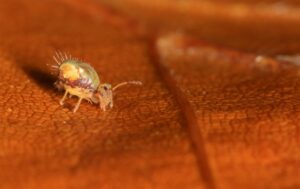
Springtails are one of the most numerous species groups found within the Recording Area
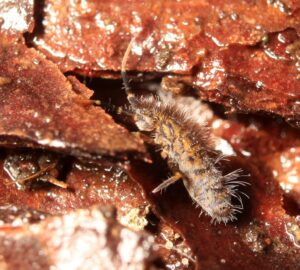
Orchesella villosa at 4mm in length, a large and hairy springtail
The most numerous and by far the most abundant species within the FBOG recording area are the springtails, barely fitting of a monster title when compared to the pond dwellers we looked at last time. These tiny creatures, many of which are smaller than a pinhead, typically occur within populations of 10,000 individuals or more per metre square of soil, which can amazingly rise to 200,000 in some favourable habitats. Springtails are little known and unsung heroes which are just as important as earthworms in many ways – for recycling organic material into soil, which is essential for plants, and ultimately us.
As we look under a bit of buried Scots Pine brash in the Top Scrub on a mid-November morning, the first creature we encounter is Orchesella villosa – not surprisingly, a springtail. But – not only is it an absolute giant (well, in springtail terms) at 4mm, it’s also a first for our recording area!
On the base of an adjacent Willow tree is what looks like a tiny red speck meticulously checking every micro-nook and cranny in the tree trunk – an Erythraeid mite. These tiny wanderers are predators searching for even more minute prey above the soil.
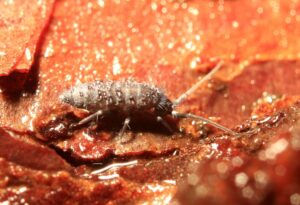
Pogonognathellus longicornis the largest species of springtail in the recording area at 6mm
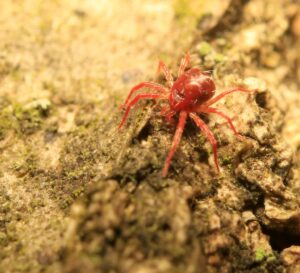
A tiny Erythraeid mite travels down a tree trunk
Back at the surface of the soil, and one of the smallest and perhaps most populous residents of the recording area – Dicyrtomina saundersi, another species of springtail. Around 2mm in length, they’re typically found under logs, on fence posts and within the leaf litter on the soil surface. They belong to a distinctive group of creatures known as globular springtails and probably qualify as little monsters in their own right, even if they’re tiny and feed on nothing as dramatic as detritus.
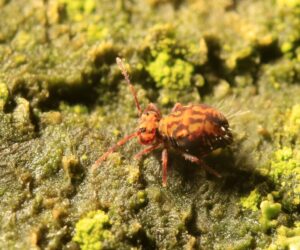
Dicyrtomina saundersi – at around 2mm, a tiny springtail and one of the commonest species in the recording area
As we lift up a stone and break the soil’s surface, we start to see creatures from deeper underground Once again springtails dominate, with Protaphorura species now becoming super abundant. These species are built for the depths with a lack of pigment and long narrow bodies for travelling through the soils matrix.
After seeing so many tiny springtails its quite a shock to find a hibernating Common Earwig Forficula auricularia beneath a stone – an absolute giant amongst the many other tiny creatures we’ve seen so far. Common Earwigs show a distinctive difference between males and females (known as sexual dimorphism), with males having rounded (cerci) on their abdomen. Alongside it is a Harvestman Nemastoma bimaculatum, a small representative of this group – which we’ll be looking at in more detail in the near future.
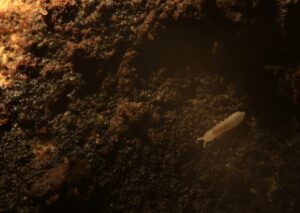
As one travels deeper underground, the springtail community changes
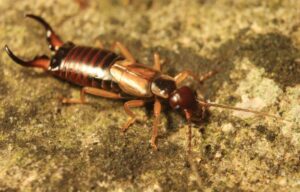
Male Forficula auricularia – a giant compared to some of the creatures that share its world
Soil is a great place for animals such as earwigs to hibernate over the winter months, and it’s not unusual to find other creatures hibernating, like bumblebees for example. This Queen Bombus terrestris is spending the winter in a dry, cool, frost-free environment. Bumblebees like Bombus terrestris typically nest below the ground in disused small mammal burrows, so conversely probably spend more time in the soil than on the flower bed.
s bumblebees demonstrate, the soil can be a great place to spend the winter away from predators and cold weather. Many insects spend the winter as larvae, so it’s not surprising that our next two finds – fly and beetle larvae – adopting the same soil strategy. These two groups have a vast diversity of species, whose larvae live a similar existence to earthworms in the winter underground.
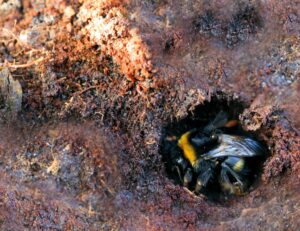
A Queen Buff-tailed Bumblebee waiting out the winter in the safety of the soil
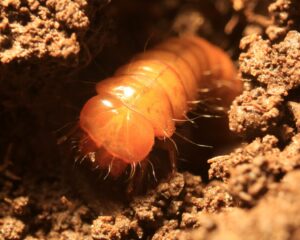
A wide variety of weird and wonderful insect larvae can be found beneath the soil’s surface
Last but not least is perhaps the most important species group in Britain, and a key prey item for everything from Toads to Badgers to Woodcock – the humble Earthworm. It seems strange to say it, but worms are arguably hugely underrated for various reasons – even aesthetically, with a good view revealing a stunning iridescence covering the entire body. Numbers typically occur in higher densities in woodland and grassland habitats. Earthworms are key decomposers, recycling leaves and similar organic materials by dragging them underground to decompose, whilst feeding on organic matter and producing soil; they’re also invaluable for aerating the soil, and aiding drainage.
So, next time you see an Earthworm, think about its hidden empire, the creatures it shares its world with, and the vitally important job they do for us.
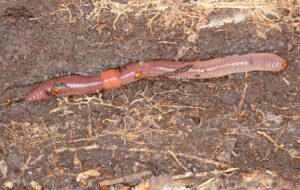
Even earthworms can show some beautiful colours when looked at closely
By Dan Lombard
